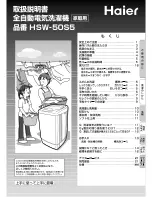
Installation
Installation
English
28
4.
Slide a hose clamp over the end of the drain hose. Attach the drain hose to the sink
connector, slide the hose clamp to the end of the hose, and then tighten the hose
clamp.
NOTE
You must use a hose clamp. Failure to do so may cause water leakage.
5.
To prevent backflow, secure the drain hose to the side or back wall of the kitchen
cabinet using cable ties or other fixtures. Make sure the drain hose height is at least
20 inches from the floor. (See
Figure 10
.)
6.
When drilling a hole for the drain hose on the cabinet wall, take caution not to damage
the drain hose by sharp edges of the hole. On wooden walls, use sand paper to soften
the edges.
On metal walls, use insulation tape or duct tape to cover the sharp edges around the
hole.
7.
Take caution not the damage the drain hose when installing the dishwasher on the
floor, wall, or cabinet.
NOTE
To prevent leaks or drainage problems, make sure the drain hose is not damaged, kinked, or
twisted.
8.
Do not cut the wrinkled area of the drain hose to fit the size. When arranging the drain
hose, take caution not to contact on sharp edges of the cabinet or under-sink.
CAUTION
• Be careful when cutting off the end of the drain hose as there is a risk of injury. Clean
around the sink’s drain connection so that it does not damage the hose. Check for any
foreign items in the drain hose and remove them.
• When arranging the drain hose, make sure the drain hose is not cut, torn, or broken by
any sharp edges of the floor, the product itself, or the cabinet. A damaged drain hose
causes a leak.
• Make sure to unplug the food disposal.
DW9900R_DD68-00208B-00_EN.indd 28
12/29/2018 1:57:45 PM







































